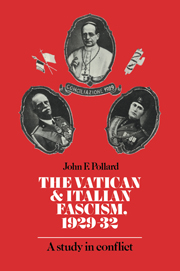Book contents
- Frontmatter
- Contents
- Acknowledgements
- Abbreviations
- 1 INTRODUCTION
- 2 THE ADVENT OF THE CONCILIAZIONE
- 3 REACTIONS TO THE CONCILIAZIONE AND THE RATIFICATION OF THE PACTS
- 4 THE DIPLOMATIC DIMENSION: ITALIAN FOREIGN POLICY AND THE VATICAN, 1929–31
- 5 THE CATHOLIC OFFENSIVE: CATHOLIC ACTION AND THE REGIME, 1929–31
- 6 THE CRISIS OF 1931
- 7 CONCLUSION AND EPILOGUE
- Appendix I The Law of Guarantees of 1871
- Appendix II The Lateran Pacts of 1929
- Appendix III The September Accords, 1931
- Appendix IV A note on archival and other sources
- Bibliography
- Index
4 - THE DIPLOMATIC DIMENSION: ITALIAN FOREIGN POLICY AND THE VATICAN, 1929–31
Published online by Cambridge University Press: 03 February 2010
- Frontmatter
- Contents
- Acknowledgements
- Abbreviations
- 1 INTRODUCTION
- 2 THE ADVENT OF THE CONCILIAZIONE
- 3 REACTIONS TO THE CONCILIAZIONE AND THE RATIFICATION OF THE PACTS
- 4 THE DIPLOMATIC DIMENSION: ITALIAN FOREIGN POLICY AND THE VATICAN, 1929–31
- 5 THE CATHOLIC OFFENSIVE: CATHOLIC ACTION AND THE REGIME, 1929–31
- 6 THE CRISIS OF 1931
- 7 CONCLUSION AND EPILOGUE
- Appendix I The Law of Guarantees of 1871
- Appendix II The Lateran Pacts of 1929
- Appendix III The September Accords, 1931
- Appendix IV A note on archival and other sources
- Bibliography
- Index
Summary
The Conciliazione of 1929 brought Mussolini and Fascist Italy great diplomatic prestige. Mussolini's personal achievement in solving the sixty-year-old ‘Roman Question’ was everywhere recognised by the foreign press; The Times, for instance, hailed him as ‘the greatest Italian statesman’, and the Hungarian Minister of Religious Affairs was reported as saying that Mussolini was ‘…the leading statesman of the post-war period’. As a result of this great personal triumph, the Duce's already high standing as a moderate, conservative statesman was enhanced. In the eyes of foreign observers, he added the re-establishment of religious peace to his long catalogue of domestic triumphs – the restoration of law and order, the attainment of political stability and the revitalisation of the economy. The Conciliazione was seen to have strengthened Italy diplomatically, especially in relation to France, the former ‘Elder Daughter of the Church’, and the French themselves felt this very deeply as their press comments on the Conciliazione demonstrate. Many Italians must have shared the exultation of the Clerico-Fascist Martire, who declared that with the decline of Spain and the demise of Habsburg Austria, Italy was now the leading Catholic power. In his triumphant celebration of the Conciliazione, Martire wrote that ‘It seems clear to us that Italy must now take on the historically necessary task of saving European civilisation.’
Naturally, Mussolini wished to exploit his new position of strength and he desired to use the ‘special relationship’ between Italy and the Vatican to further the aims of Italian foreign policy.
- Type
- Chapter
- Information
- The Vatican and Italian Fascism, 1929–32A Study in Conflict, pp. 75 - 102Publisher: Cambridge University PressPrint publication year: 1985

